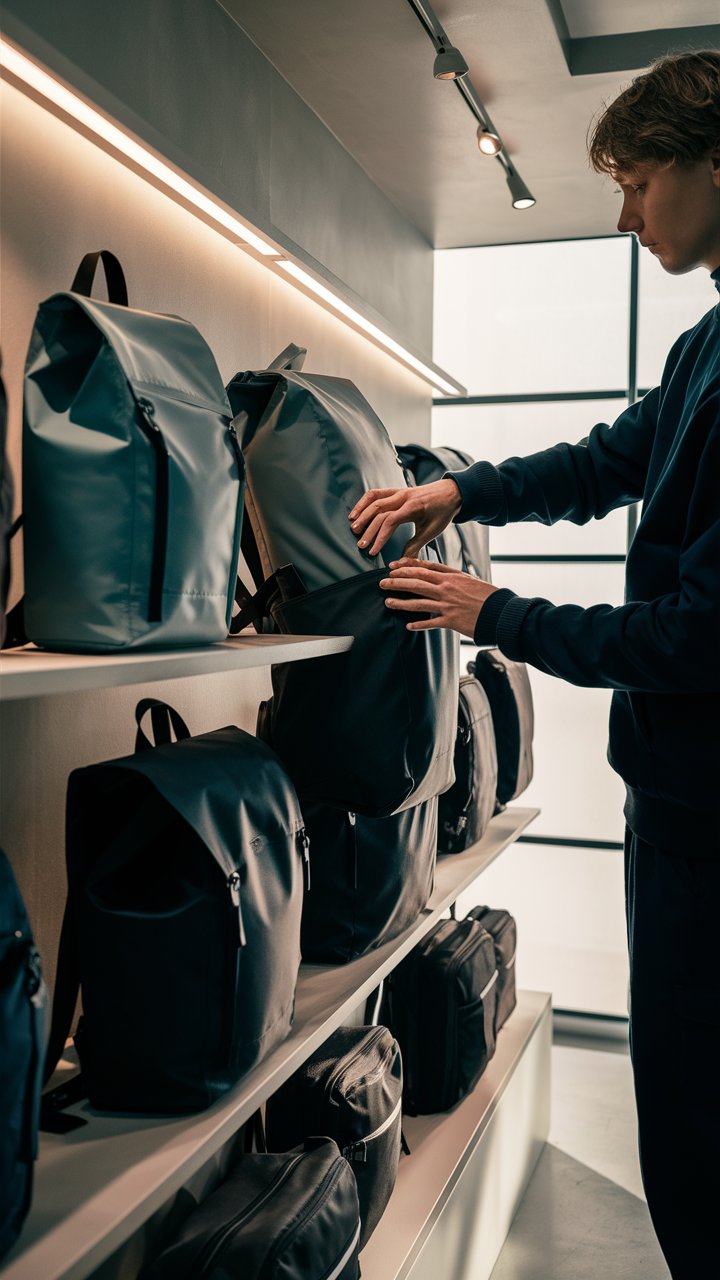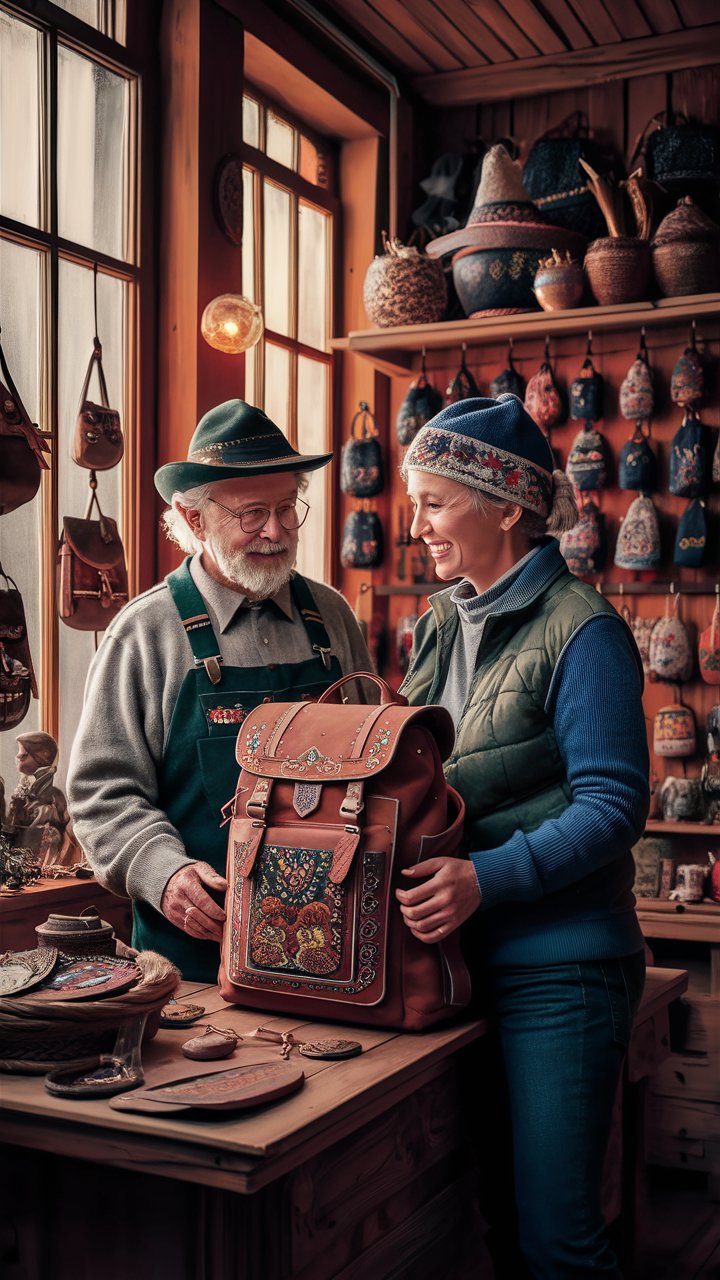Introduction
Embarking on a Finnish adventure calls for a backpack that is not just an accessory but a crucial part of your travel gear. Choosing a roomy and durable backpack tailored for varied activities—from city explorations to wilderness adventures—is essential. A backpack can take you wherever you go, ensuring all your essentials are secure and organized. With features like drawstring closures and sections in the larger zipper area, these backpacks are perfect for carrying laptops, small notebooks, and other electronics, making them ideal for anyone on the move.
Cultural sensitivity and style are key in selecting your Finland travel backpack. Incorporate elements that reflect Finnish design aesthetics, like minimalist and functional styles, which resonate with Finland’s cultural ethos. Opt for a backpack made from spun polyester, which is not only lightweight but also durable. For those seeking a blend of fashion and functionality, a backpack purse for women or a convertible handbag can be stylish yet practical choices, especially for those who transition from a day of hiking to an evening in the city.
Key Takeaways
- Prioritize choosing a backpack that is lightweight and waterproof, essential for Finland’s varied climate conditions.
- Opt for durable materials like canvas or spun polyester that offer waterproof protection and are suitable for harsh climates.
- Select backpacks that feature Finnish design elements, such as minimalist patterns or nature-inspired motifs, to enhance the cultural value of your gear.
- Investigate seller options on platforms like Etsy Finland to find unique, handcrafted travel bags, considering their shipping policies and customer feedback.
- Utilize customer reviews to gauge the backpack’s durability and functionality in various weather conditions, helping inform your purchase decision.
- Choose versatile travel bags that combine style with functionality, suitable for transitioning from outdoor adventures to city nightlife.
Essential Tips for Choosing the Perfect Cultural Backpack for Your Finland Trip

When choosing a cultural backpack for your Finland adventure, focus on essential features like lightweight and waterproof materials. Opt for a durable canvas or handbag that can endure Finland’s diverse weather conditions. Ensure the backpack has adjustable straps and multiple pockets, making it spacious enough to accommodate all your travel essentials. Consider a travel bag that mirrors Finnish aesthetic preferences, perhaps with minimalist designs or elements that reflect local culture.
Essential Features for the Perfect Finland Cultural Backpack
| Feature | Description | Why It’s Important for Finland |
|---|---|---|
| Material | Durable materials like canvas and spun polyester. | Resists wear from harsh climates and provides longevity. |
| Design | Minimalist patterns and nature-inspired motifs. | Reflects Finnish cultural aesthetics and personal style. |
| Waterproofing | Waterproof materials are a must. | Protects contents from Finland’s variable weather. |
| Comfort | Padded straps and breathable material. | Ensures comfort during long hikes and city tours. |
| Capacity | Multiple compartments and adjustable straps. | Allows for efficient organization and easy access. |
| Cultural Elements | Features that reflect Finnish culture, such as local artistic motifs or colors inspired by the landscape. | Enhances the travel experience by connecting with local traditions. |
This table is designed to provide insights into each essential feature of a cultural backpack tailored for Finland.
Selecting the Right Material for Durability and Comfort
When choosing your backpack for Finland, consider materials like canvas or spun polyester that are both durable and lightweight. These fabrics are excellent for harsh climates, offering waterproof protection and comfort during long travels. The right material can make a significant difference in the overall experience, keeping your belongings safe from weather elements and ensuring the backpack lasts through many more trips.
Integrating Finnish Design Elements into Your Backpack
Incorporating Finnish design elements such as minimalist patterns or nature-inspired motifs can significantly enhance the cultural value of your backpack. Look for designs that speak to traditional Finnish aesthetics, blending functionality with local artistry. This approach not only makes your backpack unique but also deepens your connection to Finnish culture as you travel.
Navigating Seller Options and Shipping for Your Finland Cultural Backpack

Exploring seller options on platforms like Etsy Finland can provide insights into unique, handmade travel bags filled with culture, perfect for your journey. When selecting a seller, consider their shipping policies and the availability of expedited services, especially if you need your cultural backpack, which may include cultural elements and two sections in the larger area, quickly. Review the seller’s history for reliable customer feedback, ensuring that your chosen bag is not only stylish but also meets the necessary criteria of durability and functionality, particularly if someone asks about carrying notebooks or other essentials.
Key Considerations for Purchasing a Cultural Backpack from Finnish Sellers
-
Examine Craftsmanship and Materials: Focus on sellers who specialize in using high-quality, durable materials that withstand Finland’s climate, such as waterproof fabrics and robust stitching.
-
Review Cultural Authenticity: Choose backpacks that incorporate authentic Finnish designs, such as traditional Sami patterns or natural motifs inspired by the Finnish landscape, to ensure a genuine cultural connection.
-
Check Seller Credentials: Prioritize sellers on platforms like Etsy Finland with strong customer feedback, especially those with certifications or awards for craftsmanship and design excellence.
-
Understand Return Policies and Warranties: Ensure you are aware of the seller’s return policies and whether they offer warranties, which can provide peace of mind and protection for your investment.
-
Evaluate Environmental and Ethical Practices: Consider sellers who practice ethical manufacturing and use environmentally sustainable materials, aligning with Finland’s high environmental standards.
This list expands upon the topic of navigating seller options, emphasizing the practical, cultural, and ethical considerations essential when selecting a cultural backpack for your Finland adventure.
Understanding Shipping Policies and Costs
Before purchasing a cultural backpack from an online seller, it’s essential to understand their shipping policies and associated costs. Check if the seller offers shipping insurance and trackable shipping options to Finland. These factors can affect how quickly and securely your backpack arrives, ensuring that you’re not caught off guard by unexpected delays or expenses.
Choosing Reliable Sellers on Etsy Finland
Etsy Finland is a treasure trove for finding unique, handcrafted backpacks. When selecting a seller, look for those with high ratings and positive reviews, especially from buyers who purchased similar items. This can give you confidence in the seller’s reliability and the quality of their products, making your purchase decision easier and safer.
Why Customer Reviews Are Key to Selecting the Best Travel Backpack for Finland

Customer reviews are invaluable when choosing your travel backpack for Finland, especially for women’s needs or the african american community focusing on black history. They offer firsthand insights into the backpack’s durability, comfort, particularly in stowing items like toiletry essentials, and how it holds up in various weather conditions, including brazil‘s humidity or thailand‘s rains. Look for reviews discussing the backpack fashion and its section perfect for carrying notebooks, ensuring they are foldable and display adequate width. Reviews can also highlight issues with zippers, straps, or pockets, helping you make a more informed decision on its functionality and style.
Analyzing Reviews for Product Quality Insights
Dive into customer reviews to gather detailed information on the backpack’s performance. Pay special attention to comments about the material’s resilience in cold or wet conditions, the functionality of pockets and zippers, and overall comfort. These reviews can reveal crucial details that are not always apparent in product descriptions.
The Impact of Negative Reviews on Buying Decisions
Negative reviews should not be overlooked as they often contain critical insights about the backpack’s drawbacks. Whether it’s issues with durability, design flaws, or poor customer service, such feedback can guide you to avoid potential pitfalls and select a product that has consistently satisfied customers.
“The best advice I can give to anyone looking to buy a new backpack is to read reviews written by people who have marched a thousand miles in those boots—or backpacks. There’s no substitute for tried and tested gear, especially when it takes you into the heart of Finland’s nature.” – Bear Grylls
Combining Style and Functionality: The Ultimate Guide to Fashionable Travel Bags for Finland

Your travel bag for Finland should be a perfect blend of style and practicality. Opt for a fashionable backpack that goes beyond mere functionality. Consider trendy options like crossbody bags, tote bags, or convertible purses that offer versatility and fashion-forward appeal. These bags should have sufficient sections for laptops and other electronics, ensuring they are as functional as they are stylish. Materials like spun polyester or leather can add a touch of elegance while still being strong and long-lasting.
Fashionable Features That Enhance Travel Convenience
Consider travel bags that offer features like insulated sections for food, hidden pockets for valuables, or an adjustable strap system. These features not only enhance the bag’s functionality but also keep you traveling in style, whether you’re exploring the city or venturing into Finland’s natural landscapes.
Transitioning from Day to Night: Versatile Travel Bag Designs
For travelers who move from day activities to evening outings, versatile bag designs like convertible backpacks to shoulder bags or tote to crossbody bags are ideal. These designs allow for easy transition and adaptability, reflecting both practicality and fashion sense, perfectly suited for the dynamic environment of Finland.
- BPA-Free Sports Water Bottle
- Great for Travel
- 32 Oz, Shy Marshmallow
Conclusion
As you conclude your search for the ideal backpack for your Finnish journey, remember that the perfect blend of style and functionality is within reach. Opting for a reusable, lightweight, and durable backpack that embodies Finnish minimalistic design not only complements your travel wardrobe but also supports your varied activities. These backpacks, with their multiple sections and adjustable features, cater to everything from carrying laptops and electronics to accommodating unexpected shopping finds, making them indispensable travel companions.
Considering the cultural value and practicality, choose a backpack that reflects both your aesthetic preferences and functional needs. Whether you’re navigating the urban sprawl of Helsinki or trekking through Lapland, your backpack is more than just a container—it’s a part of your journey’s narrative, blending personalization, craft, and comfort. Ensure it has Etsy privacy settings and meets privacy standards to keep your belongings safe wherever you roam. This approach not only enhances your travel experience but also ensures you are well-prepared for any adventure that Finland has to offer.

James Dunnington leads the James Dunnington Collection, featuring five unique blogs: a practical Pet Care Guide, an enlightening Ancient History Blog, a resourceful Home Improvement Guide, a cutting-edge Tech Innovation Guide, and a strategic Online Money Making platform. Each site delivers valuable insights designed to empower and inform. For updates and more tips, visit our Contact Us page to sign up for our newsletter, ensuring you never miss out on the latest content from any of these dynamic fields.

